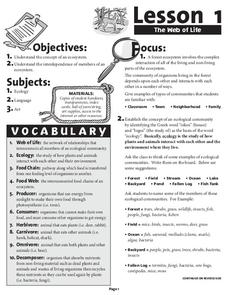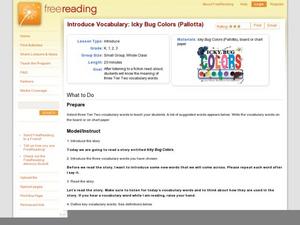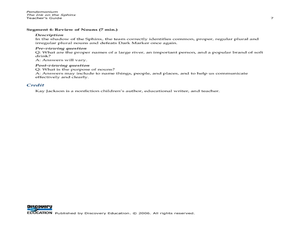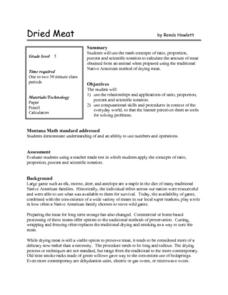Curated OER
Native Lands: Indians in Georgia
Students investigate the Native Americans of the Muscogee Creek and their use of the land. In this U.S. history lesson, students investigate the importance of the deer for the Muscogee Creek peoples' way of life and the many uses they...
Teach With Movies
Title: "The Yearling" - Topics: Literature/U.S.; U.S./1865-1913 & Florida
Life in the Florida swamps after the Civil War comes alive in the 1946 film adaptation of Majorie Kinnan Rawlings’s The Yearling. The film of this powerful coming-of-age story, filled with love and loss, can be used with or without a...
Curated OER
Distinguishing Clan Roles
Students discuss the roles of the 8 Seminole clans: Wind, Panther, Bird, Snake, Bear, Big Town, Deer and Otter. They discuss the matriarchal nature of the Seminole sociey. They interview family members and then create an illustrated...
Curated OER
Hunting, Farming and Market Gardening
Learners examine the hunting and farming practices of the Black Pioneer. They identify crops raised by black pioneers, and explore the contribution of children to the success of the family farm. Students explore the importance of...
Forest Foundation
The Web of Life
Producers, herbivores, carnivores, omnivores, decomposers. To begin a study of the forest ecosystem, learners examine the connections among the members of ecological communities.
Curated OER
The Wingra Marsh: A Purple Population Problem
Learners engage students in an ecological inquiry. They author a presentation to the Grounds Management Committee of their school giving their recommendation for the control of the invasive species purple loosestrife (Lythrum salicaria)...
Curated OER
Introduce Vocabulary: Icky Bug Colors (Pallotta)
Get to know the bugs around us with emerging readers who use Jerry Pallotta's informative book Icky Bug Colors to learn vocabulary in context. Address terms before reading the text aloud, preparing kids to listen for them later. Here,...
Curated OER
What's Right and Wrong? Moral Messages in Art
Students explore the Steen and Mount paintings and their presentation of moral issues. They discuss ethical debates in society today and write a short position paper on an issue raised by the paintings or in the discussion. They make a...
Curated OER
Explore the Arctic: A Scavenger Hunt
Pupils explore the Arctic region using the internet. They identify characteristics of animals that live in the Arctic and locate the Arctic region using a map of the United States.
Curated OER
The Westing Game: Chapters 21-24
In this comprehension check worksheet, students respond to 24 short answer questions covering chapters 21-24 of The Westing Game by Ellen Raskin.
Curated OER
The Birchbark House: Chapter 11
In this The Birchbark House comprehension check worksheet, students respond to 25 short answer questions covering chapter 11 of "The Birchbark House" by Louise Erdrich in order to help them better understand the novel.
Curated OER
Living in an "Olympic" Country
Students research countries participating in the Olympic Games. They create a database which includes graphs for comparing population density, the number of athletes, per capita income, etc. for each country. This project is completed...
Curated OER
Animal Signs
Students discuss the many different types of animal signs that can be used to identify and track animals. They participate in an hands-on activity in which they examine tracks, trails, homes, territory markings, and even "scat" left by...
Curated OER
Pendemonium - The Ink on the Sphinx
Students define and identify nouns. In this nouns lesson, students watch a video and review proper and common nouns before constructing a noun pyramid. They present their noun pyramids to the class and add them to a bulletin board.
Curated OER
Dried Meat
Students investigate the traditional method of drying meat used by Native Americans. They apply math concepts such as ratio, proportion, percent, and scientific notation to determine the amount of meat the is dried from an animal using...
Curated OER
Powhatan Gender Roles
In this Powhatan gender roles worksheet, students read a 4-page selection regarding the gender roles in Powhatan culture. Students discuss the selection.
Curated OER
The Coyote Population: Kansas Prairies
Students discover animal lifestyles by researching their ecosystem. In this animal statistics lesson, students research the geography of Kansas and discuss the reasons why wild animals survive in the open Kansas fields. Students complete...
Curated OER
Introduce Vocabulary: Icky Bug Colors
Students explore the story Icky Bug Colors. In this language arts lesson, students listen to the story and discuss the vocabulary words. Students discuss the word meanings and use them in a sentence.
Curated OER
Shiloh chapter 15
In this comprehension worksheet, learners read chapter 15 of Shiloh and complete multiple choice questions. Students complete 9 questions.
Curated OER
Animals in Japan
Young scholars compare and contrast common animals children love and have as pets in Japan and America in this early elementary lesson. The culminating project is an original work of art by each student depicting an animal of their choice.
Curated OER
Yearly Place Based theme
Students are awaken to their surroundings. They gain a greater access of how their city was formed. Students assess the human impact on the land. They comprehend the cultural diversity of the city.






















